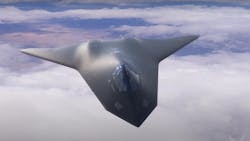U.S. military spending headed up in 2023, with $773 billion proposed for programs, research, and procurement
WASHINGTON – U.S. military spending is set to increase once again against next year. The proposed 2023 U.S. Department of Defense (DOD) budget, submitted to Congress on Monday, would spend $773 billion next year, which is up 8.1 percent from the 2022 request of $715 billion.
Military technology spending also is headed up, with proposed expenditures for research, development, test, and evaluation (RDT&E) next year of $130.1 billion, which is up 16.2 percent from the 2022 request of $112 billion.
The Pentagon research budget pays for developing enabling technologies in crucial disciplines such as artificial intelligence (AI), hypersonic munitions, electro-optical sensors, digital signal processing, electromagnetic warfare, high-performance computing, image processing, and electronic warfare (EW).
In addition to AI, the proposed 2023 Pentagon research budget includes $16.5 billion for science and technology; $3.3 billion for microelectronics technologies; and $250 million for 5G wireless communications enabling technologies.
Related: Pentagon asks for record military research spending
The military procurement budget also will see increases, with proposed spending next year of $145.9 billion, which is up 9.2 percent from the 2022 request of $133.6 billion. Procurement typically concerns spending for large items like ships, submarines, aircraft, and armored combat vehicles.
Procurement is to develop, procure, and modernize capabilities to ensure combat-credible forces across all domains to address the pacing challenge from the People’s Republic of China and to address acute threats from Russia, DOD officials say.
Among proposed procurement projects in 2023 is to modernize all three legs of the U.S. nuclear triad of intercontinental ballistic missiles (ICBMs), ballistic missile submarines, and nuclear-capable bomber aircraft.
Among the nuclear modernization proposed spending in the 2023 DOD budget is $6.3 billion for the future Columbia-class ballistic missile submarine; $5 billion for the future B-21 long-range strike bomber; and $3.6 billion for the Ground Based Strategic Deterrent ICBM.
Related: Budget: U.S. defense industry can breathe sigh of relief
Proposed combat aircraft spending next year includes $11 billion for 61 F-35 joint strike fighter aircraft; $2.8 billion for 24 F-15EX air-superiority jet fighters; $2.9 billion for 15 KC-46 airborne refueling tankers; and $1.7 billion for research into future U.S. Air Force Next Generation Air Dominance (NGAD) sixth-generation jet fighter aircraft.
The 2023 DOD budget also has $5.6 billion for two Navy Arleigh Burke-class destroyer surface warships; $1.3 billion for one FFG(X) frigate; and $7.3 billion for two Virginia-class fast-attack submarines.
For land combat, the 2023 DOD budget has $381 million for 72 Armored Multi-Purpose Vehicles; $631 million for 74 Amphibious Combat Vehicles; and $1.1 billion for 3,721 Joint Light Tactical Vehicles (JLTVs).
Proposed spending for ballistic missile defense includes $2.6 billion for Ground-Based Midcourse (GMD) and Improved Homeland Defense/Next Generation Interceptors (NGI); $335 million for the Terminal High Altitude Area Defense (THAAD) missile-defense system; $1 billion for the PATRIOT Advanced Capability (PAC-3) missile segment enhancement.
Related: 2022 DOD budget would boost spending to $715 billion
The budget also proposes $7.2 billion for Long-Range Fires to procure survivable, precision-strike, and long-range hypersonic and subsonic missiles.
Investments for space systems would include $4.7 billion for Space Based Overhead Persistent Infrared (OPIR) Systems; $1.8 billion for two Global Positioning System (GPS) Enterprise spacecraft; and $1.6 billion for six National Security Space Launch (NSSL) and Rocket System Launch Program (RSLP) launch vehicles.
The 2023 DOD budget also proposes $11.2 billion for cyber security, including Operationalizing Zero Trust Architecture across Military Departments and Defense Agencies; and increasing cyber security support to the defense industrial base; and growing the cyber mission force teams.
About the Author
John Keller
Editor-in-Chief
John Keller is the Editor-in-Chief, Military & Aerospace Electronics Magazine--provides extensive coverage and analysis of enabling electronics and optoelectronic technologies in military, space and commercial aviation applications. John has been a member of the Military & Aerospace Electronics staff since 1989 and chief editor since 1995.
